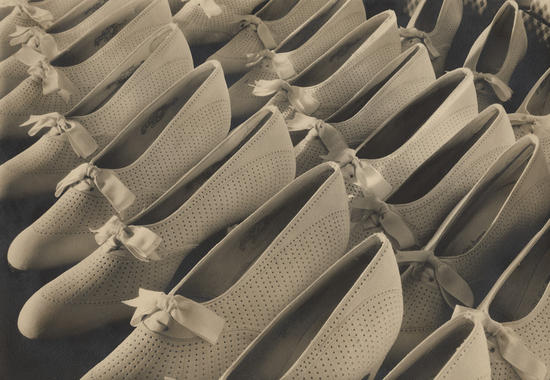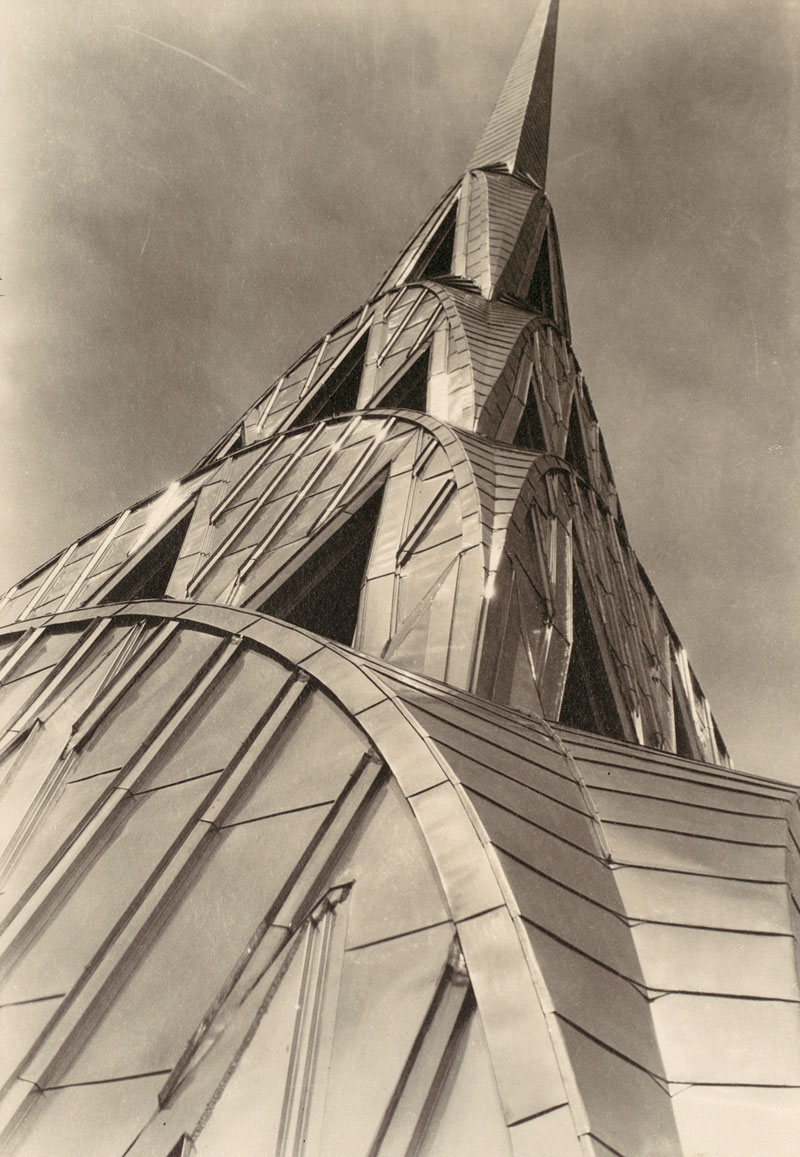A special exhibition that explored the evolution of documentary images through the work of three of the foremost photographers of the 20th century was on view at the Art Institute of Chicago from February 5 through May 15, 2011. American Modern: Abbott, Evans, Bourke-White presented Abbott (1898–1991), Walker Evans (1903–1975), and Margaret Bourke-White (1906–1971)—all taken between the years of 1929, when the stock market crashed, and 1941, when Pearl Harbor was bombed.
This exhibition not only showed, for the first time, the photographs of Abbott, Evans, and Bourke-White in relation to one another, but it also chronicled how documentary photography had a hand in transforming modern art in America.
It was during this period, the 1930s, that photographers pushed the genre of documentary photography to the forefront of public culture in the United States and onto the walls of newly opened museums and art galleries. Photographic activity blossomed in America during the Great Depression, and the genre of documentary emerged as a primary mode of relaying and understanding contemporary events and the nation’s role in them. While the world was in a turbulent state—national and international economies were being severely tested, political systems were in flux, and Europe was preparing again for war—Americans recognized their own viable cultural heritage and sought to record and expand that history. Indeed, the country’s literary, artistic, and architectural expressions all flourished in the period’s explosion of popular literature, the founding of new art museums, and the establishment of New Deal government-funded arts programs. At the same time, advances in technology, production, and distribution transformed mass media in the United States: Americans enjoyed weekly picture magazines, radio broadcasts, and popular movies in unprecedented numbers.
Photography played an especially critical role in contemporary culture, appearing in books, newspapers, and magazines as well as being accorded exhibitions in art museums and galleries. It could be argued that it was during this decade that photography became a truly popular art, infiltrating every home and newsstand and captivating an anxious audience. And photography began redefining itself, crossing the boundaries between public and private use, impersonal documentation and expressive creation, and popular visual culture and fine art. American Modern examines the practice of documentary photography through the work of three of the most important photographers of the decade, each of whom contributed a fundamental, independent, and novel idea about documentary to the common pool of artistic practice.
For Berenice Abbott, who photographed the transformation of New York City into a modern metropolis, it was the notion that photography was a means of critical dialogue and communication. She always seemed to include a human element that suggested the sacrifice or promise of living alongside new buildings.
Walker Evans, who worked with the Farm Security Administration, shot some of the most iconic images from the Great Depression. He thoroughly investigated the idea that photography has a unique and essential relationship to time. Evans was not as captivated with the new urbanization as Abbott; he tended to photograph people within environments exhibiting a universal humanity, even amid a great deal of tragedy. As Evans said, at the time, "I'm doing this for the record alone."
Margaret Bourke-White—the first female photographer for Life magazine and the first female war correspondent—fused the logic and pageantry of modern industry with the drama and individual narratives of its subjects. Her images emphasized the diminution of humans framed by the colossus of industrialization, placing anonymous workers amid enormous gears, smokestacks, and turbines. Machinery became a heroic element, the people dwarfed by their scale if not the business of production itself. Together for the first time in the exhibition, these works offer a compelling glimpse of a moment of great transformation in the United States and suggest how documentary photography reframed artistic priorities across many media.

A scholarly catalogue, published by the University of California Press, accompanied the exhibition. The 213-page American Modern includes spectacular images by Berenice Abbott, Walker Evans, and Margaret Bourke-White, and features essays by co-curators Jessica May, Sharon Corwin, and Terri Weissman. It can be purchased in hardcover for $39.95 in the Museum Shop.
American Modern: Abbott, Evans, Bourke-White was co-organized by the Amon Carter Museum and the Colby College Museum of Art in Waterville, Maine. The exhibition is curated by Jessica May, assistant curator of photography at the Amon Carter Museum; Sharon Corwin, the Carolyn Muzzy Director and Chief Curator of the Colby College Museum of Art; and Terri Weissman, assistant professor of art history at the University of Illinois, Urbana-Champaign. The Chicago presentation is curated by Katherine Bussard, associate curator of photography at the Art Institute of Chicago.
Images:

Walker Evans. Posed Portraits, New York, 1932. The Art Institute of Chicago, Gift of Mrs. James Ward Thorne. © Walker Evans Archive, The Metropolitan Museum of Art.

Walker Evans (1903–1975) [Lunchroom Window, New York City], 1929. Gelatin silver print © Walker Evans Archive, The Metropolitan Museum of Art. The Metropolitan Museum of Art, Gift of Arnold H. Crane, 1971, 1971.646.35
Margaret Bourke-White (1906–1971), (Iron Mountain, Tennessee), 1937. Gelatin silver print. © Estate of Margaret Bourke-White/ Licensed by VAGA, New York, NY. Margaret Bourke-White Collection, Special Collections Research Center, Syracuse University Library.

Berenice Abbott Canyon, Broadway and Exchange Place, 1936 Gelatin silver print, 9 5/16 x 7 1/2 inches
National Gallery of Art, Gift of Marvin Breckinridge Patterson

Margaret Bourke-White (1906-1971). Delman Shoes, 1933. Gelatin silver print. Margaret Bourke-White Collection, Special Collections Research Center, Syracuse University Library. © Estate of Margaret Bourke-White/ Licensed by VAGA, New York, NY.

Berenice Abbott (1898-1991). Hell Gate Bridge, 1937. Gelatin silver print. Collection of Norma B. Marin, Courtesy Meredith Ward Fine Art.

Berenice Abbott (1898-1991). Bread Store, 259 Bleeker Street, 1937. Gelatin silver print. Museum of the City of New York, 49.282.57.

Berenice Abbott (1898-1991). Manhattan Bridge Looking Up, 1936. Gelatin silver print. The Art Institute of Chicago, Works Progress Administration Allocation, 1389.1943.

Walker Evans (1903-1975). Penny Picture Display, Savannah, 1936. Gelatin silver print. Amon Carter Museum, P1987.4.1.

Berenice Abbott (1898-1991). Squibb Building with Sherry Netherland in Background, 1935. Gelatin silver print. Collection of Norma B. Marin, Courtesy Meredith Ward Fine Art.
Walker Evans (1903-1975). People in Downtown Havana, 1933. Gelatin silver print. The Metropolitan Museum of Art, Gift of Lincoln Kirstein, 1952, 52.562.7. © Walker Evans Archive, The Metropolitan Museum of Art.

Margaret Bourke-White (1906–1971) Chrysler Building, New York, ca. 1930–31 Gelatin silver print
© Estate of Margaret Bourke-White/ Licensed by VAGA, New York, NY
The Metropolitan Museum of Art, Ford Motor Company Collection

Margaret Bourke-White: You Have Seen Their Faces: Little boy and hound dog, 1936 Gelatin silver print ©Time Inc.
Truck and Sign, 1930 Vintage gelatin silver print 16.3 x 22.3 cm Private collection (c) Walker Evans Archive, The Metropolitan Museum of Art